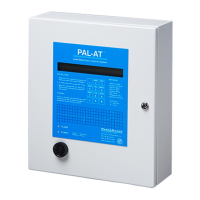PAL-AT Installation Manual
72
10 ATP Cable in Polyurethane Foam Insulation
10.1 General
This section outlines installation procedures for ATP twisted pair leak detection cable. The cable has two
insulated solid copper wires, one red and the other white. It is installed at the factory in polyurethane foam
insulation.
The cable is typically installed at the 12 o’clock position in the foam insulation for straight runs. It may be
in other orientations for fittings and returns from branch runs, so check the drawing layout for specific job
information. It is very important that the ATP cable be installed straight across each field joint. The
pipe should be rotated so the location where the ATP cable exits the polyurethane foam in adjacent
pipe sections line up to each other. The exit location is stenciled “ATP” on the pipe jacket.
10.2 Pipe Installation Precautions
Extra cable extends past each end of the pipe and is coiled around the pipe to protect it during shipping.
The extra cable must be protected from damage and must be moved away from the pipe before
welding the pipe. Repeated bending of the cable can also damage it.
There are several techniques to protect the ATP cable during the pipe welding/brazing process, depending
on the pipe dimensions and material. The cable can be exposed to temperatures of 300°F [150°C] for a
short time. A wet rag next to the cable can reduce the temperature sufficiently in some cases. If the ATP
cable is within 6” from the weld, additional precautions must be taken. There are heat block insulator
paste products available that can be placed on the pipe between the heat source and the cable. Typically,
the process involves applying a thick layer of insulator paste around the pipe and then removing it after
the welding operation (per manufacturer’s instructions).
10.3 System Configuration
A PAL-AT Leak Detection and Location System can monitor 1 to 4 cables, or sensing strings, depending
on the model. A sensing string used to monitor ATP must only monitor ATP. No jumper cable,
probes or other types of sensor cables can be connected to the string.
An ATP cable string has at least 50' [15 m] of ATP connected to the panel that replaces the standard
jumper cable. The ATP “jumper” cable connects directly to the ATP cable in the pipe foam insulation at
the start of the pipeline. Watertight electrical conduit should be used to protect the cable and keep it dry.
The watertight requirement for conduit is critical to prevent false alarms.
10.4 Calibration Points
During the initial setup and calibration of the PAL-AT system, connectors at selected locations, called
calibration points, are temporarily disconnected. Therefore, it is imperative to have accessibility to
connectors at calibration points at all times until the system is brought on-line. The cable at these
locations can be prepared for permanent crimp connectors, but the connectors should not be crimped until
the calibration process is completed for each section. A reusable connector (CAGOLD) can be installed
at these points to allow multiple making/breaking the connection if needed (see section 8.2.4).
10.5 ATP Cable and Connector Testing Procedures
The following “Continuity Test” and “Insulation Test with Wet Cloth” should be performed after
each pair of crimp connectors is installed at a field joint, prior to installing the polyurethane foam.
In addition, the continuity test and standard insulation test should be performed again, prior to backfilling
the pipe. When performing connector tests, if a CAGOLD connector is used, the center pin of the UHF
connector is connected to the red wire and the connector housing is connected to the white wire.
A 9-volt digital multimeter, e.g. a Fluke Model 75, can be used for the continuity test and a 500-volt
megger must be used for the insulation test.

